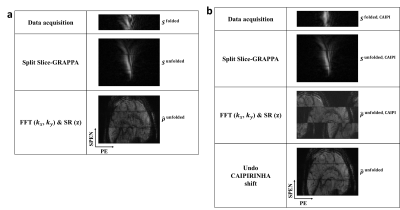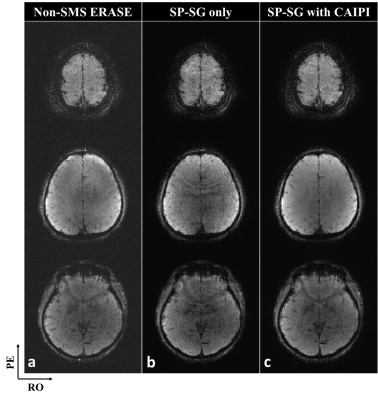2443
Reconstruction for Simultaneous Multi-Slab Spatiotemporal Encoding (SMS SPEN) Using Split Slice-GRAPPA combined with CAIPIRINHA1Department of Biomedical Engineering, Sungkyunkwan University, Suwon, Korea, Republic of, 2Department of Intelligent Precision Healthcare Convergence, Sungkyunkwan University, Suwon, Korea, Republic of, 3Siemens Healthineers Ltd., Seoul, Korea, Republic of
Synopsis
To reduce acquisition time, acceleration techniques such as simultaneous multi-slice and parallel imaging techniques have been applied to various sequences. In this work, we proposed a reconstruction method for simultaneous multi-slab spatiotemporal-encoding (SMS SPEN) using split slice-GRAPPA combined with CAIPIRINHA. The proposed method was applied to the recently developed ultrafast 3D SPEN imaging sequence called ERASE (Equal-TE Rapid Acquisition with Sequential Excitation) and a case of multiband factor of 3 was demonstrated with human brain imaging at 3T.
Introduction
To reduce the scan time without compromising spatial resolution, advanced acceleration techniques such as parallel imaging1 and simultaneous multi-slice2 imaging have been developed in combination with numerous conventional imaging sequences, including ultrafast echo-planar imaging (EPI).3 Recently, they have also been applied to novel ultrafast imaging techniques using spatiotemporal encoding (SPEN), which is non-Fourier encoding using frequency-swept pulses. For example, Schmidt et al.4 proposed parallel SPEN imaging that combines multiband frequency-swept pulses with a super-resolved SPEN reconstruction algorithm and SENSE technique5. In this study, we propose a reconstruction method for simultaneous multi-slab (SMS) spatiotemporal encoding (SMS SPEN) using split slice-GRAPPA6 combined with CAIPIRINHA7 imaging. Its performance was demonstrated in the case of a multiband factor of 3 by human brain imaging at 3T.Method
Pulse sequence: The proposed method was applied to the recently developed 3D ultrafast gradient echo-based SPEN imaging sequence called ERASE (Equal-TE Rapid Acquisition with Sequential Excitation), which provides constant TE in the SPEN direction with high tolerance B0 inhomogeneity (Fig.1a).8 A linearly frequency-swept WURST-20 pulse9 was used for slab selection because of more desirable excitation profile than a chirp pulse. The superposition of each single-band frequency-swept excitation was implemented for multiband excitation (Fig.1b). The slab-selection gradient was calculated based on the full-width-at-half-maximum (FWHM) of the excitation profile obtained from Bloch simulation using a triple-band WURST-20 pulse (Fig.1c). The CAIPIRINHA method (CAIPI) was employed to reduce aliasing especially when a multiband factor greater than two is used. To implement CAIPI, an additional phase of π was added to the WURST-20 pulse for every even k-space line in the phase-encoding direction.Image reconstruction: To demonstrate the performance of the proposed method, the multiband acceleration factor (or MB factor) was set to 3 (Fig.1b&c). Image reconstruction was performed by applying split slice-GRAPPA (SP-SG) for SMS SPEN reconstruction to unfold the superimposed data. To prevent each band's quadratic phase profile from interfering each other during the super-resolved (SR) reconstruction, SP-SG reconstruction was performed earlier than SR reconstruction. We used a SR reconstruction algorithm proposed by Chen et al10. Each step of the reconstruction process is shown in Fig.2 with each resulting image.
Experiments: All experiments were performed at 3T (Prisma, Siemens) using a 64-channel head/neck coil. Scan parameters for ERASE imaging were: FOV = 216×216 mm2, matrix size = 108×108, slab thickness = 32 mm, TR = 60 ms, TE = 29 ms, pulse time-bandwidth product (= Te×BW) = 146, pulse length (Te) = 24.68 ms, and MB factor = 3.
Results
Figure 2 shows an example of sagittal slices containing the SPEN direction of the SMS 3D ERASE images at each step of the reconstruction process. The sagittal image reconstructed via SP-SG combined with CAIPI (a) showed better image quality than the one obtained without CAIPI, demonstrating successful SMS reconstruction in the SPEN (or slab-selective) direction.Figure 3 shows three axial (in-plane) slices of 3D ERASE images reconstructed in different conditions: (a) Original 3D ERASE images acquired without SMS excitation for reference, (b) SMS 3D ERASE images acquired without CAIPI and reconstructed using SP-SG, (c) SMS 3D ERASE images acquired with CAIPI and reconstructed using SP-SG. When only SP-SG was used for SMS SPEN reconstruction without CAIPI, some artifacts appeared in these axial images due to incomplete SMS reconstruction in the SPEN direction (Fig.3b). When combined with CAIPI in data acquisition, however, these artifacts were completely gone (Fig.3c).
Discussion and Conclusion
In this study, we proposed a reconstruction method for simultaneous multi-slab spatiotemporal encoding (SMS SPEN) using split slice-GRAPPA (SP-SG) combined with CAIPIRINHA (CAIPI). SMS 3D ERASE images were well reconstructed by applying SP-SG combined with CAIPI-implemented data acquisition, showing good image quality without image artifacts due to incomplete reconstruction of SMS SPEN. Since only MB factor 3 was used here, the proposed method needs to be further tested in combination with in-plane acceleration for higher acceleration. Comparisons between the proposed GRAPPA-based method and other SENSE-based methods4 also need to be investigated in future studies.Acknowledgements
This work was supported by NRF-2020R1A2B5B02002676 and NRF-2019M3C7A1031993.References
[1] Griswold MA, Jakob PM, Heidemann RM, et al. Generalized autocalibrating partially parallel acquisitions (GRAPPA). Magn Reson Med. 2002;47:1202-1210.
[2] Feinberg DA, Setsompop K. Ultra-fast MRI of the human brain with simultaneous multi-slice imaging. J Magn Reson. 2013;229:90-100.
[3] Ogawa S, Lee TM, Kay AR, Tank DW. Brain magnetic resonance imaging with contrast dependent on blood oxygenation. Proc Natl Acad Sci USA. 1990;87:9868-9872.
[4] Schmidt R, Baishya B, Ben-Eliezer N, Seginer A, Frydman L. Super-resolved parallel MRI by spatiotemporal encoding. Magn Reson Imag. 2014;32:60–70.
[5] Pruessmann KP, Weiger M, Scheidegger B, Boesiger P. SENSE: sensitivity encoding for fast MRI. Magn Reson Med. 1999;42:952–962.
[6] Cauley SF, Polimeni JR, Bhat H, Wald LL, Setsompop K. Interslice Leakage Artifact Reduction Technique for Simultaneous Multislice Acquisitions. Magn Reson Med. 2014;72:93-102.
[7] Breuer FA, Blaimer M, Heidemann RM, Mueller MF, Griswold MA, Jakob PM. Controlled aliasing in parallel imaging results in higher acceleration (CAIPIRINHA) for multi‐slice imaging. Magn Reson Med. 2005;53(3):684-691.
[8] Ryu JK, Han SH, Oh SH, Lee JS, Kim SG, Park JY. An equal-TE ultrafast 3D gradient-echo imaging method with high tolerance to magnetic susceptibility artifacts: Application to BOLD functional MRI. Magn Reson Med. 2021;85(4):1986–2000.
[9] O’Dell LA. The WURST kind of pulses in solid-state NMR. Solid State Nuclear Magn Reson. 2013;55-56:28-41.
[10] Chen Y, Li J, Qu XB, Chen L, Cai CB, Cai SH, Zhong JH, Chen Z. Partial Fourier transform reconstruction for single-shot MRI with linear frequency-swept excitation. Magn Reson Med. 2013;69:1326-1336.
Figures


